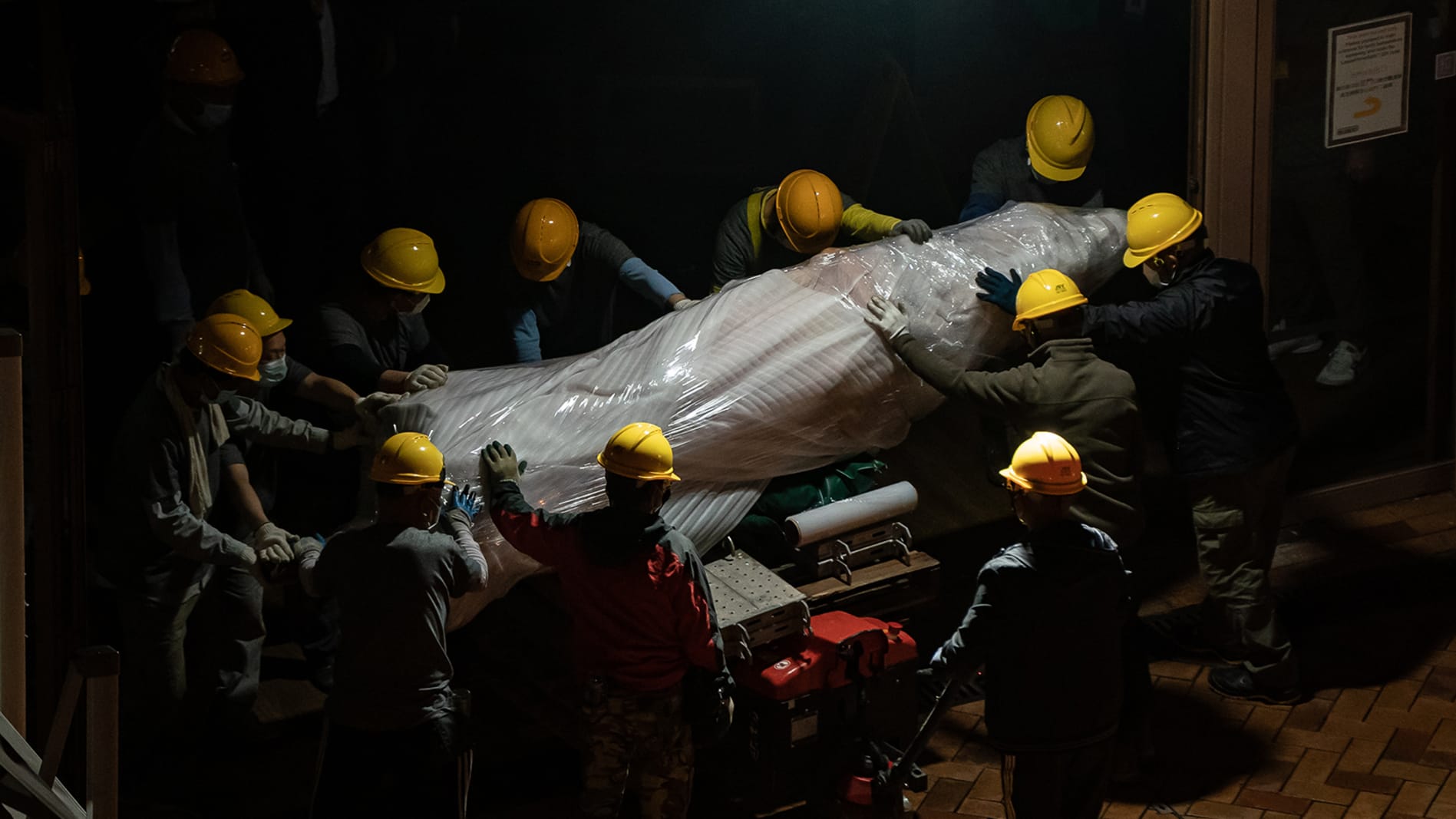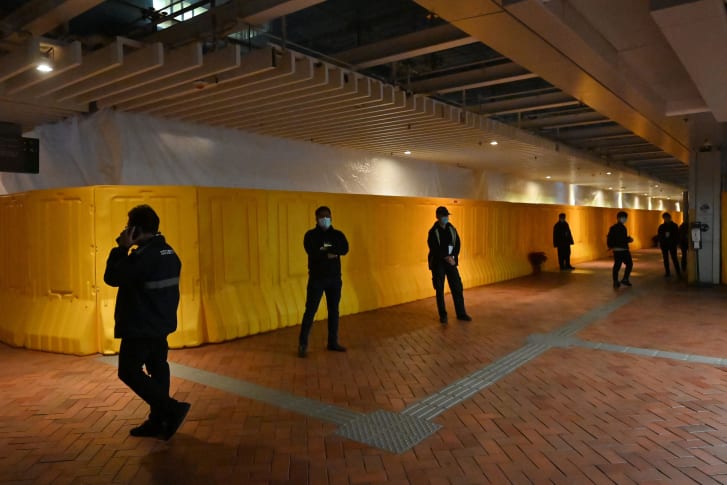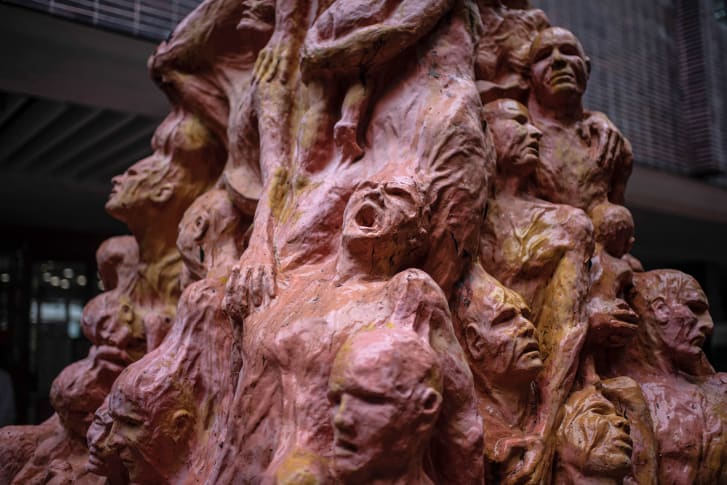22nd December 2021

Credit: Anthony Kwan/Getty Images
By Helen Regan, Wayne Chang, Teele Rebane, Karen Smith,
For more than 20 years the "Pillar of Shame" sculpture stood as a memorial to the victims of the 1989 Tiananmen Square massacre, in which the Chinese military crushed protests led by college students in Beijing with deadly force.
Atop a podium in the University of Hong Kong's (HKU) campus, the 26-foot-tall (8 meter) statue of contorted human torsos was one of the last iconic memorials to victims of the bloody crackdown remaining on Hong Kong soil.
But around midnight on Thursday, yellow construction barriers were erected around the statue and the sounds of cracking and demolition were heard as the sculpture was removed under the cover of darkness.
Images taken during the removal process show workers wrapping the statue in protective film and lifting it out of the campus on a crane in two distinct parts. The HKU Council, the university's governing body, said in a statement the sculpture will be held in storage.

Two children look at the "Pillar of Shame" statue at the Hong Kong University campus on October 15, 2021 in Hong Kong.
The HKU Council said in a statement the removal "was based on external legal advice and risk assessment for the best interest of the university."
Hong Kong national security police investigate Tiananmen Square vigil organizers
The sculpture, which stood in the Haking Wong Building of the university, was part of a series of works by Danish artist Jens Galschiøt created in 1997 -- the year Hong Kong was returned to China after more than 150 years of British rule. The sculpture includes the inscription: "The old cannot kill the young forever," and was built to serve "as a warning and a reminder to people of a shameful event which must never reoccur," according to the description on Galschiøt's website.
For three decades, Hong Kong has been the only place on Chinese-controlled soil where an annual mass vigil has been held to mark the events in and around Tiananmen Square on June 4, 1989.
The clampdown remains one of the most tightly censored topics in mainland China, with discussions of it scrubbed from mass media. Chinese authorities have not released an official death toll, but estimates range from several hundred to thousands.

Security guards stand in front of barriers erected around the 26-foot-tall "Pillar of Shame."
However, in the wake of national security law, scores of prominent pro-democracy politicians and activists have been jailed or fled the city, and numerous civil society groups have disbanded.
The last two June 4 vigils have been banned by police, citing coronavirus restrictions. Prominent activists, including Joshua Wong and Media tycoon Jimmy Lai, were later jailed for participating in commemoration events in 2020.
A Hong Kong museum dedicated to the victims of June 4 was forced to close earlier this year and moved its entire collection online citing "political oppression."

A security guard stands in front of a shipping container as barriers and security people guard "Pillar of Shame" at Hong Kong University, as the sculpture is removed.
Following news the sculpture was being dismantled, the artist Galschiøt wrote on his Twitter account, "I'm totally shocked that Hong Kong University is currently destroying the pillar of shame. It is completely unreasonable and a self-immolation against private property in Hong Kong."
"We encourage everyone to go out to Hong Kong University and document everything that happens with the sculpture," he added in a statement. We have done everything we can to tell the University of Hong Kong that we would very much like to pick up the sculpture and bring it to Denmark."
In its statement, HKU Council said, "No party has ever obtained any approval from the University to display the statue on campus, and the University has the right to take appropriate actions to handle it at any time."

A close-up of the "Pillar of Shame."
It added the university "is also very concerned about the potential safety issues resulting from the fragile statue. Latest legal advice given to the University cautioned that the continued display of the statue would pose legal risks to the University based on the Crimes Ordinance enacted under the Hong Kong colonial government."
Efforts to preserve the memory of the sculpture are already underway, with art-activist group Lady Liberty Hong Kong creating a 3-D model made using more than 900 photos in October.
"The idea is that everyone can print a copy it and place it wherever they want," said Alex Lee, the founder of the group. "In the digital age, there's no limitation of what you can do with virtual or physical objects -- (the hope is) for everyone to try to preserve this symbol."

Workers remove part of the "Pillar of Shame" statue into a container at University of Hong Kong on December 23.
On Sunday, Hong Kong's first "China patriots only" legislative election witnessed a record low turnout, reflecting a steep decline in civic and political engagement following Beijing's overhaul of the city's electoral processes earlier this year.
Following the vote, Hong Kong Chief Executive Carrie Lam traveled to Beijing and met with Chinese Leader Xi Jinping, who endorsed her administration and praised her for moving the city "from chaos to order," according to a government statement of the meeting.
Calling the election -- in which turnout was just 30.2% -- a "success" Xi said the city had "made solid progress in promoting democratic development that suits Hong Kong's reality."
"The democratic right of Hong Kong compatriots has been shown," Xi said.
A number of Hong Kong activists who fled abroad labeled the election -- in which prospective candidates were first screened by the government -- as a "sham," a criticism echoed by many rights groups and international observers.
Top image: Workers remove part of the "Pillar of Shame" into a container at the University of Hong Kong on December 23, 2021
CNN Hong Kong
For more than 20 years the "Pillar of Shame" sculpture stood as a memorial to the victims of the 1989 Tiananmen Square massacre, in which the Chinese military crushed protests led by college students in Beijing with deadly force.
Atop a podium in the University of Hong Kong's (HKU) campus, the 26-foot-tall (8 meter) statue of contorted human torsos was one of the last iconic memorials to victims of the bloody crackdown remaining on Hong Kong soil.
But around midnight on Thursday, yellow construction barriers were erected around the statue and the sounds of cracking and demolition were heard as the sculpture was removed under the cover of darkness.
Images taken during the removal process show workers wrapping the statue in protective film and lifting it out of the campus on a crane in two distinct parts. The HKU Council, the university's governing body, said in a statement the sculpture will be held in storage.

Two children look at the "Pillar of Shame" statue at the Hong Kong University campus on October 15, 2021 in Hong Kong.
Credit: Louise Delmotte/Getty Images AsiaPac/Getty Images
A witness said Thursday morning the site of the sculpture is now empty and students have been seen crying on campus following the removal. CNN agreed to not disclose the name of this witness because the person feared retribution from authorities.
That fear of retribution is common among those who speak out against authorities in Hong Kong since Beijing imposed the National Security Law on the city in 2020, punishing offenses such as subversion and secession with sentences of up to life in prison.
That fear of retribution is common among those who speak out against authorities in Hong Kong since Beijing imposed the National Security Law on the city in 2020, punishing offenses such as subversion and secession with sentences of up to life in prison.
The HKU Council said in a statement the removal "was based on external legal advice and risk assessment for the best interest of the university."
Hong Kong national security police investigate Tiananmen Square vigil organizers
The sculpture, which stood in the Haking Wong Building of the university, was part of a series of works by Danish artist Jens Galschiøt created in 1997 -- the year Hong Kong was returned to China after more than 150 years of British rule. The sculpture includes the inscription: "The old cannot kill the young forever," and was built to serve "as a warning and a reminder to people of a shameful event which must never reoccur," according to the description on Galschiøt's website.
For three decades, Hong Kong has been the only place on Chinese-controlled soil where an annual mass vigil has been held to mark the events in and around Tiananmen Square on June 4, 1989.
The clampdown remains one of the most tightly censored topics in mainland China, with discussions of it scrubbed from mass media. Chinese authorities have not released an official death toll, but estimates range from several hundred to thousands.

Security guards stand in front of barriers erected around the 26-foot-tall "Pillar of Shame."
Credit: Peter Parks/AFP/Getty Images
After the 1997 handover, the continuation of the vigil and similar memorials were seen as a litmus test for Hong Kong's ongoing autonomy and democratic freedoms, as promised in its de facto constitution.
However, in the wake of national security law, scores of prominent pro-democracy politicians and activists have been jailed or fled the city, and numerous civil society groups have disbanded.
The last two June 4 vigils have been banned by police, citing coronavirus restrictions. Prominent activists, including Joshua Wong and Media tycoon Jimmy Lai, were later jailed for participating in commemoration events in 2020.
A Hong Kong museum dedicated to the victims of June 4 was forced to close earlier this year and moved its entire collection online citing "political oppression."

A security guard stands in front of a shipping container as barriers and security people guard "Pillar of Shame" at Hong Kong University, as the sculpture is removed.
Credit: Peter Parks/AFP/Getty Images
Following news the sculpture was being dismantled, the artist Galschiøt wrote on his Twitter account, "I'm totally shocked that Hong Kong University is currently destroying the pillar of shame. It is completely unreasonable and a self-immolation against private property in Hong Kong."
"We encourage everyone to go out to Hong Kong University and document everything that happens with the sculpture," he added in a statement. We have done everything we can to tell the University of Hong Kong that we would very much like to pick up the sculpture and bring it to Denmark."
In its statement, HKU Council said, "No party has ever obtained any approval from the University to display the statue on campus, and the University has the right to take appropriate actions to handle it at any time."

A close-up of the "Pillar of Shame."
Credit: Louise Delmotte/Getty Images AsiaPac/Getty Images
It added the university "is also very concerned about the potential safety issues resulting from the fragile statue. Latest legal advice given to the University cautioned that the continued display of the statue would pose legal risks to the University based on the Crimes Ordinance enacted under the Hong Kong colonial government."
Efforts to preserve the memory of the sculpture are already underway, with art-activist group Lady Liberty Hong Kong creating a 3-D model made using more than 900 photos in October.
"The idea is that everyone can print a copy it and place it wherever they want," said Alex Lee, the founder of the group. "In the digital age, there's no limitation of what you can do with virtual or physical objects -- (the hope is) for everyone to try to preserve this symbol."

Workers remove part of the "Pillar of Shame" statue into a container at University of Hong Kong on December 23.
Credit: Anthony Kwan/Getty Images
On Sunday, Hong Kong's first "China patriots only" legislative election witnessed a record low turnout, reflecting a steep decline in civic and political engagement following Beijing's overhaul of the city's electoral processes earlier this year.
Following the vote, Hong Kong Chief Executive Carrie Lam traveled to Beijing and met with Chinese Leader Xi Jinping, who endorsed her administration and praised her for moving the city "from chaos to order," according to a government statement of the meeting.
Calling the election -- in which turnout was just 30.2% -- a "success" Xi said the city had "made solid progress in promoting democratic development that suits Hong Kong's reality."
"The democratic right of Hong Kong compatriots has been shown," Xi said.
A number of Hong Kong activists who fled abroad labeled the election -- in which prospective candidates were first screened by the government -- as a "sham," a criticism echoed by many rights groups and international observers.
Top image: Workers remove part of the "Pillar of Shame" into a container at the University of Hong Kong on December 23, 2021








